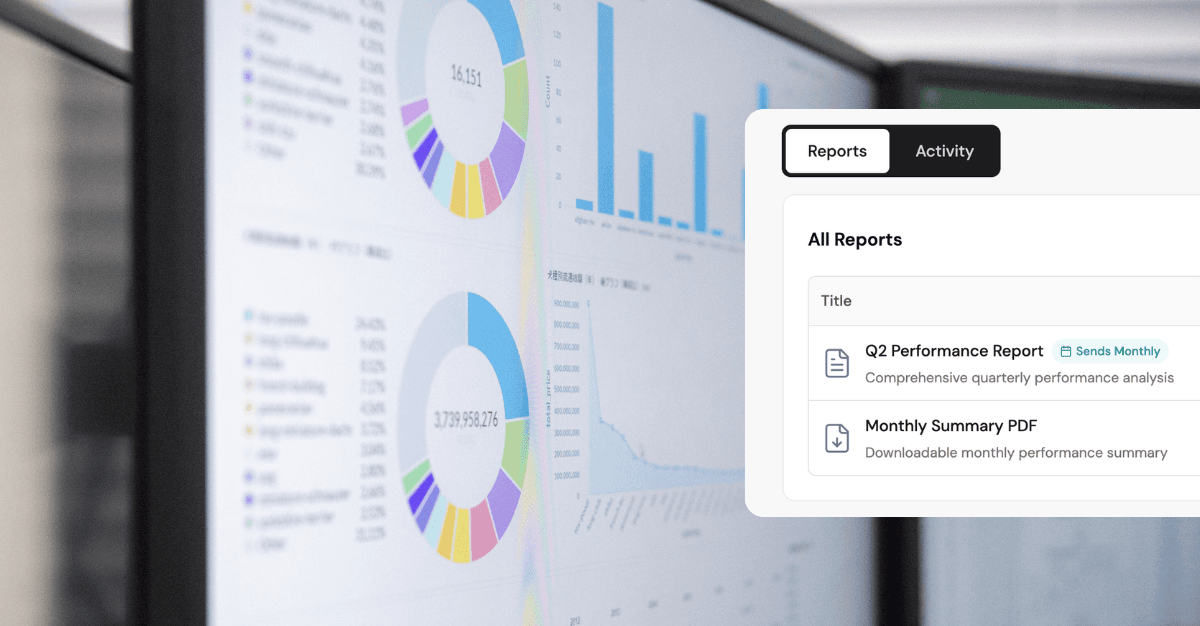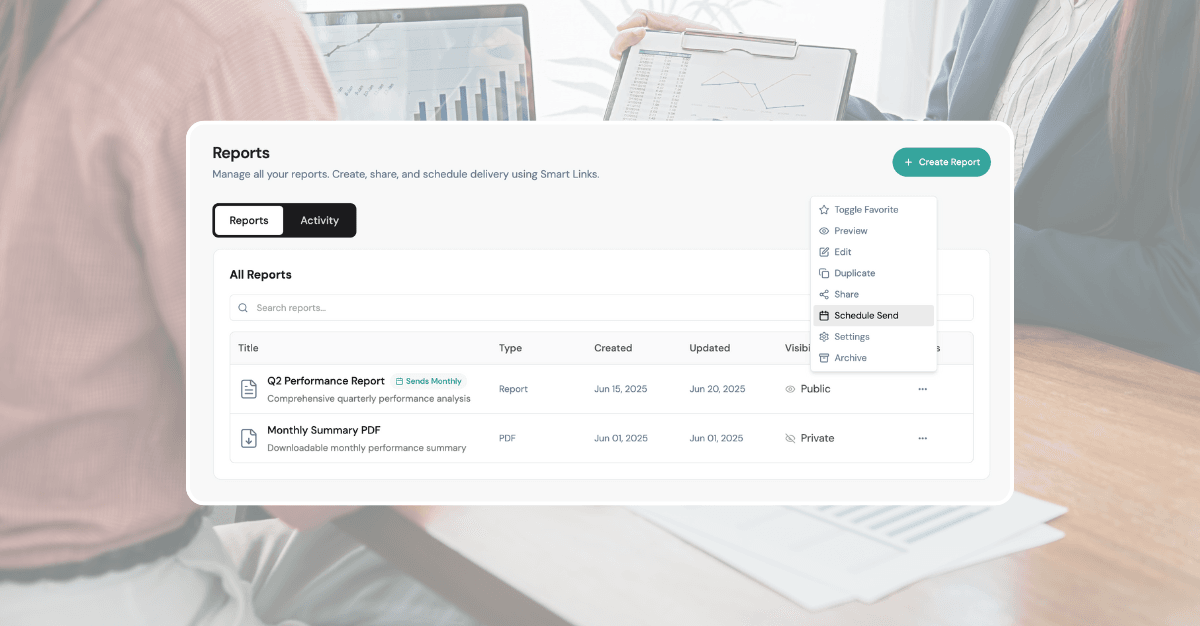The Complete Guide to Client Reporting Automation
Transform your agency's efficiency with automated reporting systems that save time while delivering better insights to clients.
Gideon Banks
••7 min readMarketing Analytics Expert

The Complete Guide to Client Reporting Automation
Manual client reporting is the bane of every marketing agency's existence. Hours spent copying data, formatting charts, and creating presentations—time that could be better spent on strategy and optimization. But what if you could automate 90% of your reporting process while actually improving the quality of insights you deliver?
The Hidden Cost of Manual Reporting
Let's face the numbers:
- Average agency spends 8-12 hours per client per month on reporting
- 60% of that time is spent on data collection and formatting
- Only 40% is spent on actual analysis and insights
- Manual errors occur in 23% of reports (industry average)
For a 20-client agency, that's 160-240 hours monthly—equivalent to one full-time employee.
The Automation Opportunity
Reporting automation isn't just about saving time—it's about transforming your entire client relationship:
Immediate Benefits
- Time Savings: 80-90% reduction in report preparation time
- Consistency: Standardized formatting and calculations across all clients
- Accuracy: Elimination of copy-paste errors and calculation mistakes
- Scalability: Handle more clients without proportional staff increases
Strategic Advantages
- Real-time Insights: Always-current data instead of month-old snapshots
- Deeper Analysis: More time for strategic thinking and recommendations
- Client Satisfaction: Faster turnaround and more comprehensive insights
- Competitive Edge: Professional presentation and advanced capabilities
Building Your Automation Strategy
Phase 1: Assessment and Planning
Audit Your Current Process
- Map out every step in your reporting workflow
- Identify time-consuming manual tasks
- Document data sources and update frequencies
- Catalog report templates and formats
Define Automation Goals
- Set specific time-saving targets
- Identify quality improvement opportunities
- Plan for scalability requirements
- Establish success metrics
Phase 2: Data Infrastructure
Centralize Data Sources The foundation of automated reporting is unified data:
- Connect all marketing platforms (Google, Facebook, LinkedIn, etc.)
- Integrate CRM and sales data
- Include website analytics and conversion tracking
- Sync financial and ROI data
Establish Data Quality Standards
- Implement validation rules for incoming data
- Set up anomaly detection for unusual patterns
- Create data backup and recovery procedures
- Monitor data freshness and completeness
Phase 3: Template Development
Create Standardized Templates Develop templates that balance consistency with customization:
- Executive summary with key metrics
- Performance deep-dives by channel
- ROI and attribution analysis
- Competitive benchmarking sections
- Action items and recommendations
Design for Multiple Formats
- Interactive dashboards for real-time monitoring
- PDF reports for formal presentations
- PowerPoint templates for client meetings
- Email summaries for quick updates
Key Components of Automated Reporting
1. Data Collection and Processing
Automated Data Extraction
- Schedule regular API calls to all platforms
- Implement error handling and retry logic
- Normalize data formats and time zones
- Validate data quality before processing
Intelligent Data Transformation
- Calculate custom metrics and KPIs
- Apply attribution modeling
- Segment data by relevant dimensions
- Create trend analysis and comparisons
2. Dynamic Content Generation
Automated Insights
- Generate natural language summaries of performance
- Identify significant changes and trends
- Create personalized recommendations
- Highlight areas requiring attention
Visual Elements
- Automatically update charts and graphs
- Apply consistent branding and styling
- Generate appropriate visualizations for data types
- Create mobile-friendly layouts
3. Distribution and Delivery
Scheduled Delivery
- Automate report generation and sending
- Customize delivery schedules per client
- Include relevant attachments and supplementary data
- Track delivery and engagement metrics
Multi-Channel Distribution
- Email delivery with embedded visualizations
- Dashboard links for real-time access
- Slack or Teams notifications for urgent updates
- API endpoints for client system integration
Advanced Automation Features
Predictive Analytics
- Forecast future performance based on historical trends
- Identify opportunities for optimization
- Predict budget requirements and ROI expectations
- Flag potential issues before they impact performance
Anomaly Detection
- Automatically identify unusual performance patterns
- Alert teams to significant changes in real-time
- Distinguish between normal variation and actionable insights
- Provide context for anomalies when possible
Competitive Intelligence
- Automatically gather competitive data where available
- Compare client performance to industry benchmarks
- Track competitive campaign activity and strategies
- Generate competitive analysis sections
Custom Calculations
- Implement client-specific metrics and KPIs
- Handle complex attribution models
- Calculate lifetime value and customer acquisition costs
- Generate margin and profitability analysis
Technology Stack Considerations
Reporting Platforms
Enterprise Solutions:
- Tableau, Power BI for advanced visualizations
- Looker, Sisense for embedded analytics
- Custom solutions using React/D3.js
Marketing-Specific:
- Modalboard for agency-focused automation
- Supermetrics for data collection and basic reporting
- TapClicks for multi-client management
Data Integration Tools
- Zapier/Make for simple integrations
- Fivetran/Stitch for robust data pipelines
- Custom APIs for specialized requirements
- Modalboard's native connectors for marketing platforms
Infrastructure Components
- Cloud data warehouses (Snowflake, BigQuery)
- Message queues for reliable processing
- CDNs for fast report delivery
- Authentication systems for secure access
Implementation Best Practices
Start Small, Scale Fast
- Begin with your most important clients
- Focus on high-impact, low-complexity reports first
- Iterate based on feedback before scaling
- Maintain manual backup processes during transition
Maintain the Human Touch
- Always include strategic commentary and insights
- Provide contact information for questions
- Schedule regular review calls to discuss automated reports
- Use automation to enhance, not replace, client relationships
Quality Assurance
- Implement multi-stage review processes
- Set up automated testing for data accuracy
- Create manual spot-check procedures
- Maintain version control for templates and calculations
Training and Change Management
- Train team members on new automated systems
- Create documentation for common tasks and troubleshooting
- Establish clear escalation procedures for issues
- Celebrate early wins to build momentum
Common Automation Pitfalls
Over-Automation
- Don't automate everything immediately
- Maintain flexibility for client-specific requests
- Keep human oversight for strategic decisions
- Allow for manual overrides when necessary
Poor Data Quality
- Garbage in, garbage out applies to automation
- Invest in data validation and cleaning
- Monitor for API changes and deprecations
- Have backup data sources when possible
Lack of Customization
- Avoid one-size-fits-all approaches
- Allow for client-specific branding and metrics
- Provide different levels of detail for different audiences
- Enable easy customization of report sections
Insufficient Testing
- Test automation with historical data first
- Validate calculations against manual reports
- Check formatting across different devices and platforms
- Have rollback procedures for system failures
Measuring Success
Efficiency Metrics
- Time spent on report creation (before vs. after)
- Number of manual errors reduced
- Client capacity per team member
- Cost per report generated
Quality Metrics
- Client satisfaction scores
- Report accuracy rates
- Insight depth and relevance
- Response time to client questions
Business Impact
- Client retention rates
- New client acquisition capacity
- Team productivity improvements
- Revenue per employee
The Future of Automated Reporting
AI-Powered Insights
- Natural language generation for report narratives
- Automated strategy recommendations
- Predictive modeling for campaign optimization
- Intelligent alerting based on business context
Enhanced Interactivity
- Voice-activated queries and commands
- Augmented reality data visualization
- Collaborative editing and annotation
- Real-time discussion threads
Integration Expansion
- Direct integration with client business systems
- Automated action triggers based on performance thresholds
- Cross-platform campaign optimization
- Unified customer journey tracking
Getting Started with Modalboard
At Modalboard, we've designed our platform specifically for marketing agencies looking to automate their reporting:
Pre-Built Templates
- Industry-specific report templates
- Customizable branding and layouts
- Multi-format output options
- White-label capabilities
Intelligent Automation
- AI-powered insight generation
- Automated anomaly detection
- Predictive performance modeling
- Natural language summaries
Seamless Integration
- 50+ native platform connectors
- Real-time data synchronization
- Flexible API endpoints
- Enterprise security standards
Conclusion
Reporting automation is no longer a luxury—it's a necessity for competitive marketing agencies. The time and quality benefits are too significant to ignore, and client expectations continue to rise.
The key is to approach automation strategically: start with your biggest pain points, maintain focus on client value, and continuously iterate based on feedback and results.
Done right, automated reporting doesn't just save time—it transforms your agency into a more strategic, scalable, and profitable business.
Ready to automate your client reporting? Start your free trial with Modalboard and see how we can transform your agency's reporting process in just a few clicks.
Gideon Banks
•Marketing Analytics Expert

